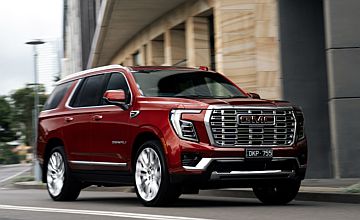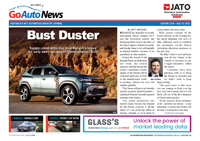Make / Model Search
OptionsCar reviews - GMC - Yukon - DenaliGMC modelsOverviewWe like Clever chassis and good visibility help mammoth SUV ‘shrink around the driver’, comprehensive equipment, effortless V8, class-leading towing capacity and supporting tech Room for improvement Interior materials don’t match the price, wooden brake pedal feel, low-speed ride cannot hide truck origins, jiggly and jerky when towing, sub-par payload Yuge American SUV drives very well with impressive tech – but contains compromises12 May 2025 Overview
Built in Texas and almost as big, the 2025 GMC Yukon Denali arrives in Australia as flagbearer for the aspirational American brand’s official debut Down Under, bringing US-style luxury and unique capabilities (such as a 3628kg towing capacity) to the local SUV market.
Priced at $174,990 plus on-road costs, this full-sized eight-seat, eight-cylinder SUV comes loaded with premium features to help justify a substantial price that, considering Luxury Car Tax and the amount of work that must go into reengineering it for right-hand drive, is a modest $30K impost over what you’d pay in California (at May 2025 exchange rates) for a similarly specified example.
Although it competes with luxury three-row SUVs with off-road and towing capabilities such as the Lexus LX (five or seven seats) and Land Rover Defender 130 (up to eight seats), the Yukon Denali is conceptually similar to the Ford Everest Platinum in that it is a ute-based SUV with all the trimmings (and a mountain-inspired name).
Given you could buy two Everest Platinums and come away with almost $11K in change for the cost of a single GMC Yukon Denali, it’s just as well that The General has packed this ‘professional grade’ four-wheel drive wagon with clever tech and features that set it apart from your common or garden SUV.
Key to this is the combination of air suspension for all four wheels and GM’s decades of experience in expertly calibrating what it calls Magnetic Ride Control (AKA adaptive dampers). More on that later.
Another factor is the 313kW/624Nm 6.2-litre petrol V8 that, on paper at least, is almost as fuel-efficient as the turbo-petrol V6 of a similarly priced Lexus LX 600 but almost a teetotaller compared with Nissan’s 5.6L V8 in the not-long-for-this-world Y62 Patrol (which also happens to be available with eight seats, but only in Ti trim when not kitted out with the Ti-L’s heavier equipment).
Once that Patrol gets consigned to history, a V8 in a vehicle like this will get even harder to find, with an eight-cylinder, eight-seat Land Rover Defender 130 commanding another $40K or so on top of what GMC is asking for a Yukon Denali. Both have similar fuel consumption figures, though.
Who is buying one of these with one eye on the bowser anyway? Perhaps the Nissan owner, not least because pumping 140L of 98RON takes almost as long as charging an electric car.
Still, 12.8L/100km from a car this big with this much power and torque makes the GMC something of an engineering miracle, partially enabled by the fact it can cut off four of its eight cylinders to save fuel and behind that all-American bluff – and vast – chrome radiator grille is a system of vents that only let as much air through as needed, to the benefit of aerodynamics. It is probably a similar story with the automatically stowing side steps that only present themselves when a door is opened.
Most of all, though, in a similar way to how full-size American pickup trucks can feel like a significant leap forward over the one-tonners many Aussies are used to, the GMC Yukon Denali combines sheer size and brute force with smart tech and thoughtful touches that owners will appreciate.
Drive impressions
One of the GMC’s standout features is a 3628kg braked towing capacity when fitted with the optional 70mm ball and weight distribution hitch, giving anyone regularly towing heavy loads some decent headroom over the rest of the SUV market, which tops out at 3500kg.
There is a catch, though. Maxing the GMC’s towball load rating of 363kg leaves 271kg of the Yukon Denali’s 634kg payload for people and possessions.
For comparison a Lexus LX has a 640kg payload rating (of which more is available once loading up its 3.5-tonne maximum towing capacity) while a Defender 130 can only tow 3000kg but has a 710kg payload.
A little further down the pricing tree, a LandCruiser 300 has a 650kg payload in higher trim levels (785kg for the base GX) plus a 3500kg towing capacity. Those wanting a V8 SUV with more payload might consider a Nissan Patrol Warrior that packs 736kg but is limited to a 3.5-tonne trailer.
Based on GM’s insistence that the Yukon Denali is a family car and not for grey nomads, once mum and dad are on board that’s another 159kg gone (based on average Aussie adult weights), leaving about 18.7kg for each of the kids in the remaining six seats (around the average for an Aussie five-year-old). And they’ll have to leave all their things at home (or in the trailer).
Pedantry aside, we were never in doubt that the Yukon Denali’s 313kW and 624Nm would be up to the task, especially with a buffet of ratios to choose from in the 10-speed automatic transmission, but we were still unprepared for how effortlessly this vehicle would gather pace for overtaking and speed limit changes – even with around two tonnes of horse float behind.
Aurally, you’re never going to be in any doubt about the presence of a big V8 under the bonnet while accelerating, but it settles into almost silence much of the time and seems to be calibrated to lean on low-end torque for that stealthy in-gear acceleration experience that made us grateful for the big, clear head-up display’s speed readout on numerous occasions.
Tucked by the driver’s right knee (a bit of an ergonomic fail) are buttons for the selectable four-wheel drive system that includes rear-wheel drive, all-wheel drive (Auto), high-range 4x4 and low-range 4x4 settings.
During the launch drive from Canberra to the New South Wales south coast and up to Sydney, we primarily used the Auto mode that proved useful on sections of road that rapidly transitioned between gravel and bitumen, while providing additional traction during scattered showers.
Aside from the ease with which that eager V8 could overwhelm the 285/40 Bridgestone Alenza tyres on comically large 24-inch rims in rear-drive mode, it was also worth leaving the car in Auto during a short towing loop with the unladen horse float hitched up.
Rear-drive mode would yield marginal fuel-efficiency gains but might be worth selecting on long, dry motorway runs. We didn’t get to play with the 4x4 modes – and 24-inch wheels would not exactly encourage buyers to venture too far off the beaten track.
Beneath the driveline controls is a knob for selecting drive modes, with Sport, Off-Road and Tow/Haul on offer besides the default.
Embedded within the knob is a button for selecting the air suspension’s ride height (the Yukon Denali will lower for entry and egress, can lift by 25mm at up to 80km/h manually or in off-road mode plus a further 25mm in the low-range 4x4 setting). It can make some startling hissing sounds reminiscent of a tyre blow-out while operating.
The air suspension ensured the big GMC remained level during towing but we were surprised by how jiggly and jerky it became with the tandem-axle float hitched up during the low-speed rural loop provided for towing tests during the launch.
On the upside, the amount of thought that has gone into the Tow/Haul mode, integrated trailer brake controller and cameras for both hitching up and monitoring the trailer will be appreciated by owners.
Also guaranteed to be appreciated by owners is the way the Yukon Denali drives. It is one of those big cars that quickly seems to shrink around the driver and soon becomes unintimidating.
The launch drive took the scenic way from Canberra to the coast, which on first impression was not the ideal way to showcase a behemoth SUV but aside from an underlying firmness wrought by those 24-inch wheels and 40-section tyres, the Yukon Denali rode and handled exceptionally well, especially on sections of twisty gravel.
Accurate, well-weighted steering and excellent visibility made this massive wagon surprisingly easy to place and the well-tuned combination of air suspension and adaptive dampers kept body roll in check while creating a secure, confidence-inspiring and tied-down feel that many much smaller SUVs – let alone truck-based body-on-frame designs like this – often struggle to deliver.
Offset undulations and rougher surfaces negotiated at low speed betrayed the GMC’s separate chassis construction with trademark shudder and wobble and we also discovered the Yukon shares a wooden brake pedal feel under harder applications with its Chevrolet Silverado stablemate (as well as heavy low-speed steering). Overall, though, the experience was one of refined capability.
That refinement extends to the transmission, which we had to force ourselves to think about such was its butler-like background behaviour. The paddle-shifters are only activated by first pushing a steering wheel button and likely only needed for towing in steep terrain or off-roading.
During brief and rare glimpses of suburbia during the launch drive, we found the Yukon Denali’s sheer bulk impossible to ignore and we were always acutely aware of the responsibility that comes with piloting something so substantial.
Helping to address this are the various active safety aids that seem better calibrated than most, working with rather than against the driver and with the option for alerts to come through vibrations in the driver’s seat instead of audible beeps and chimes no doubt appreciated by those family buyers trying to keep sleeping children undisturbed.
The Yukon Denali is remanufactured to right-hand drive in Dandenong by the same team responsible for converting the Chevrolet Silverado and we were impressed by the high standards achieved, albeit with some of the donor vehicle’s limitations exposed.
For example, the A-pillar grab handle remains on the driver’s side and is trimmed in such cheap plastic that its seams feel able to cut skin. We were also unconvinced by the number and type of textures, especially the dated and hard dash-top material that seems to be mimicking elephant leather and is somehow embellished with real stitching.
Things like this – and low-grade hard plastics found elsewhere in the cabin – would rightly feel a bit confrontational to someone with the thick end of $200K to spend on an SUV.
But for those who feel the sea of screens in a branch of JB Hi-Fi is luxurious, the Yukon will impress with its onboard technology.
The portrait-oriented 16.8-inch touchscreen takes centre stage in the cabin and controls a comprehensive suite of features including wireless Apple CarPlay and Android Auto, although in the absence of GM’s OnStar connected services Down Under there is no native sat-nav. However, climate control adjustments are always visible at the bottom of the panel along with a rotary volume knob and a welcome array of physical shortcut switches.
We found the system intuitive and responsive, with clear graphics and logical menu structures including the ability to send certain information across to the similarly impressive digital instrument panel, which can be customised to show various combinations of information. For the most part, though, our eyes were on the crisp head-up display.
A neat feature of the main touchscreen is its multitasking function that enables various ‘windows’ to be visible at once, with smartphone mirroring able to occupy the whole area or share it with native functions.
Parents and limo drivers alike will appreciate the ability to set the third climate control zone from the big touchscreen, as well as help administer the dual 12.6-inch rear entertainment screens that can share or show separate content sourced via HDMI inputs and heard through included wireless headphones.
The hi-res screen also makes the most of a comprehensive camera system that provides up to 11 different views, aiding towing and low-speed manoeuvring – particularly the side views, which are vital for protecting those massive 24-inch rims from kerb damage. Also, a reasonable 12.4-metres turning circle, given the Yukon's 5.3-metre length, made it more manageable in tight spaces than anticipated.
With seating for eight and the ability to fold both the second and third rows flat (liberating a gargantuan 3480 litres of capacity), the Yukon offers van-like versatility when needed – with enough room for a double bed with a view of the stars through that dual-pane panoramic sunroof.
Seating comfort is good rather than outstanding, with 12-way power adjustment for both front seats (on the upside it did not take endless tweaking to find a good driving position and posture). The perforated leather upholstery feels tough rather than plush, offering heating and ventilation for front occupants and heating for the second row.
While the third row is more spacious than in many competitors, with reasonable headroom (courtesy of a scalloped ceiling) and enough legroom for mid-sized adults, it was not outstanding unless the second row is slid forward to a degree that legroom becomes compromised elsewhere.
With mechanisms for remote seat folding of both the second- and third-row seating (and deployment in the case of the third) GMC has attempted to make access to the third row simple via a pillar-mounted button that folds and tumbles a second-row seat.
Unfortunately the procedure is hit-and-miss, requiring manual intervention or just putting it all back and trying again, and like many other models the side with the most logical design for entry and egress is behind the driver’s seat rather than out of the traffic on the kerb side.
Also, under the seat is a mess of exposed wires and mechanisms that look to get trampled by careless kids climbing in and out, or tampered with by curious hands. We’d also fear for the toes of third-row passengers as careless second-row occupants slam back their seat from the forward position it is left in once the backrest is folded back up.
Cabin storage is plentiful, with numerous cup holders, phone slots (and nearby USB-C charging sockets), multi-tiered door bins plus a big glovebox, sizeable central console compartment and handy dash-top hatch.
GM provides a three-year/100,000km warranty and roadside assistance for the duration, with service intervals annual or 12,000km.
In 2025 this represents a fairly meagre aftersales package compared with all of the Yukon Denali’s premium-priced-and-badged competitors that have at least five years of cover and the much less-expensive Nissan Patrol wielding a decade of service-activated backing.
Aside from this and the several foibles noted above from our five-or-so hours behind the wheel and as a passenger in the GMC Yukon Denali, we came away convinced that this vehicle meets a part of the market that was until now underserved and does so with a surprise-and-delight factor in the way it drives.
But it perhaps ticks a not-quite-right combination of boxes for those buyers – and it’s bloody expensive.
At least the fuel bills might be manageable. The twisty, hilly drive from Canberra to the coast returned mid-14s per 100km and the more straightforward trip north to Sydney was closer to GM’s high-12s claim. The two vehicles used for towing tests were showing between 16 and 20 litres per 100km on their trip computers after several slow, short loops.
 All car reviews Alfa Romeo Alfa Romeo Abarth Abarth Audi Audi Aston Martin Aston Martin BMW BMW Bentley Bentley Chrysler Chrysler Chevrolet Chevrolet Dodge Dodge Citroen Citroen Ferrari Ferrari DS DS Ford Ford Fiat Fiat FPV FPV Foton Foton Haval Haval Great Wall Great Wall Honda Honda Holden Holden Hyundai Hyundai HSV HSV Isuzu Isuzu Infiniti Infiniti Jaguar Jaguar Iveco Iveco Kia Kia Jeep Jeep Land Rover Land Rover Lamborghini Lamborghini Maserati Maserati Lexus Lexus McLaren McLaren Mazda Mazda Mercedes-Benz Mercedes-Benz Mitsubishi Mitsubishi Mini Mini Opel Opel Nissan Nissan Porsche Porsche Peugeot Peugeot Ram Ram Proton Proton Rolls-Royce Rolls-Royce Renault Renault Skoda Skoda Saab Saab SsangYong SsangYong Smart Smart Suzuki Suzuki Subaru Subaru Toyota Toyota Tesla Tesla Volvo Volvo |
OptionsClick to share
|









Facebook Twitter Instagram